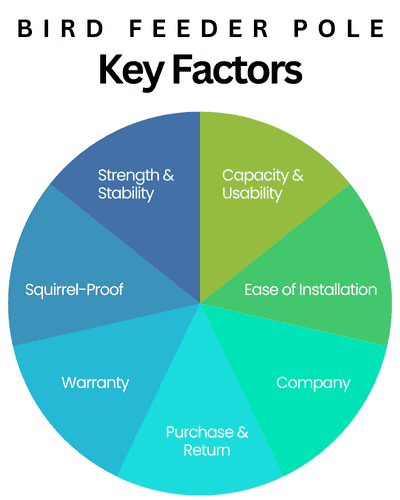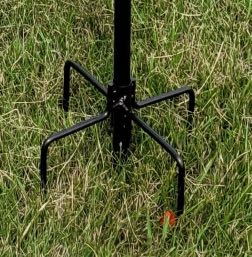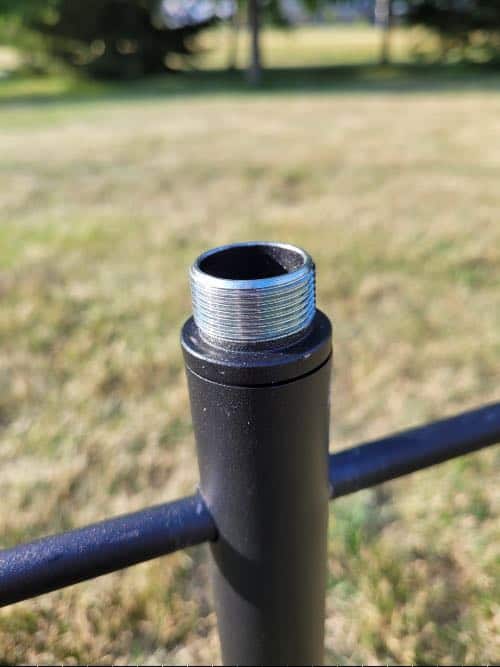I purchase and install all the bird feeder poles I review. They’re set up in my yard so I can observe and evaluate their performance, ensuring they fulfill their advertised claims.
I invested time in designing my birding gear test and score systems, with the dual objective of saving you time, money, and potential frustration, while also maintaining fairness to the brands. Ratings are designed to simplify your choices.
I’d like to further explain how I test and score bird feeder poles…
Table of Contents
Key Factors | Scoring | Strength & Stability | Capacity & Usability | Squirrel-Proof | Ease of Installation | Warranty | Purchase & Return | Company
Key Factors

I identified seven key factors to consider when testing each pole. Details about each key factor are in the next section.
- Strength & Stability
- Capacity & Usability
- Squirrel-Proof
- Ease of Installation
- Warranty
- Purchase/Return Convenience
- Company
Scoring
I use a 5-point rating system to evaluate all key factors for each product. For each factor, I assign a score and then determine the overall score by averaging these individual scores.
5.0
Perfect score. All birders will be delighted with the bird feeder pole.
4.0 – 4.9
Good score. Most birders will be happy with the bird feeder pole.
3.0 – 3.9
Fair score. Some birders will be disappointed with the bird feeder pole.
2.0 – 2.9
Poor score. Most birders will be disappointed with the bird feeder pole.
1.0 – 1.9
Very poor score. Not recommended.
Onto details of the key factors…
1. Strength & Stability
Strength and stability are the most important factors to consider when purchasing a bird feeder pole.
Strength
A sturdy bird feeder pole is crucial, as multiple bird feeders filled with birdseed can become quite heavy. Look for a pole with a thick, solid center and preferably fewer than three sections that, when connected, form a stable, non-wobbling unit.
Also, pay attention to the soldering joints for the shepherd’s hooks and make sure they look clean. Messy soldering can be an indication of carelessness and lower quality. No one wants their bird feeder dropping to the ground from a bad solder joint.
Stability
It needs to be stable enough to support uneven weight distribution without leaning. Whether you have one bird feeder hanging or four, it should stand straight and solid. The stability is based on the bottom support as well as the center pole.
Bottom Support
Poles with bottom support that go deeper into the ground provide the best stability.
Those with ground augers and a twisting rod make the task of twisting the base pole into the ground easier. Just how deep? To give you an idea – the Squirrel Stopper Sequoia goes 20″ deep into the ground.

Many budget models utilize “fork staking” for bottom support. The forks spread out and also go into the ground but only about 8″.
Stability with fork staking is determined by the distance the fork is from the center pole (longer is better), how deep in the ground each fork goes, (deeper is better), and the number of forks (more is better). Look for a model that has at least 4 forks that go into the ground at least 8″ and are at least 4.5″ from the center pole.
Center Pole
Look for one with a center pole comprised of 3 or fewer sections, made of steel, at least 1″ diameter, and the sections lock in place such as threaded connections to screw the sections together or twist and lock button.

2. Capacity & Usability
Consider how many bird feeders you’d like to hang and make sure the one you choose can support this number.
If you’re new to backyard birding and unsure, I recommend looking for one with 4 shepherds’ hooks. After you put out your first feeder and the birds start coming, you’ll be hooked (pun intended) and want to attract more birds.
Bird feeders should have ample space between each other and from the center pole for usability. That is, to prevent feeders from knocking into the pole or one another.
Space is also preferred by your feathered friends when they visit. Many are territorial – especially during breeding season – and may fight other birds at the feeder. Also, if a sick bird were to visit, more space would help mitigate the spread of illness.
Look for one whose hooks are at least 7″ from the center pole . 10″ or more is truly the ideal distance but 7″ is the minimum.
3. Squirrel-Proof
Look for one that is squirrel-proof. They will stop at nothing to get at your feeders and devour the bird food. Not only does this bust the birdseed budget but it also scares the birds away.
Many brands claim they’re “squirrel-proof”. In my experience, the ones that are close to 100% squirrel-proof are built-in (vs add-on baffles), large, smooth, and have some movement so the squirrel can’t gain leverage on it and launch upward to a feeder.
Add-on squirrel baffles are available to help keep squirrels at bay. However, they’re not usually as effective at stopping these giant rodents but usually offer relief for a while – until the squirrels in your yard have figured out the nuances of the baffle!
If you don’t have a squirrel problem, you will. And you’ll be glad you have a bird feeder pole that is squirrel-proof.
4. Ease of Installation
Nobody wants to spend hours installing the pole, nor should they need to.
Instructions are usually provided but let’s be honest, bird feeder poles are not complicated and the general concept doesn’t vary much from one brand to another.
- You have the base that attaches to the ground (via ground auger or forks);
- Center poles that attach to each other (via insert, screw together, insert with buttons);
- Hooks are installed near the top.
Higher quality models will take longer to install because the base entails twisting an auger into the ground – over 1.5′. Look for a model that includes the “twisting rod” because it makes the job significantly easier. Plus, it’s highly unlikely you already have a metal rod that is the perfect diameter, strength, and length to take don’t the task. I know I didn’t!
Budget models are generally all the same and take no time at all to install. The base entails 3-5 forks that are easily inserted into the ground by stepping on them. The center poles are just inserted as well.
5. Warranty
High-end bird feeder poles can exceed $100. To safeguard your investment, seek a robust and extended warranty. Ensure any pole you purchase for over $100 comes with a minimum 1-year warranty.
6. Purchase & Return Convenience
If you’re pressed for time or just enjoy the convenience of ordering online, there are plenty of online stores to purchase from. We all know Amazon returns are super simple, but what about fees? Make sure you understand the cost of returning if you need to. This is true even for Amazon as some stores that sell through them may charge a restocking fee.
Look for a reputable and reliable vendor to purchase from that also has an easy and fair return policy.
7. Company
Quite a few brands have set the bar high in the wild bird market, sticking around for decades because they’ve mastered the mix: high-quality products, fresh innovations, and the kind of customer service that makes you feel like old friends. Here are just a few examples of reputable companies in the bird-feeding market (in alphabetical order):
- Brome
- Droll Yankees
- JCS Wildlife
- Perky-Pet
- Squirrel Stopper
By narrowing the pool of products to the ones made by a reputable brand, you mitigate the risk of the item ending up on a garbage heap. In other words, skip the generic and white-label products.

